You may have heard of mead before or maybe you haven’t, but one image that always seems to come to mind when mead is mentioned is Vikings drinking their grog. I don’t know a whole lot about Vikings, but I do know a bit about mead! Mead is a fermented honey and water mixture, some call it honey wine, and it is quite possibly the first fermented drink that humans purposefully made. Luckily for us, it’s quite easy to make your own mead! I’m going to show you how to make one gallon of mead with this simple blueberry orange mead recipe.
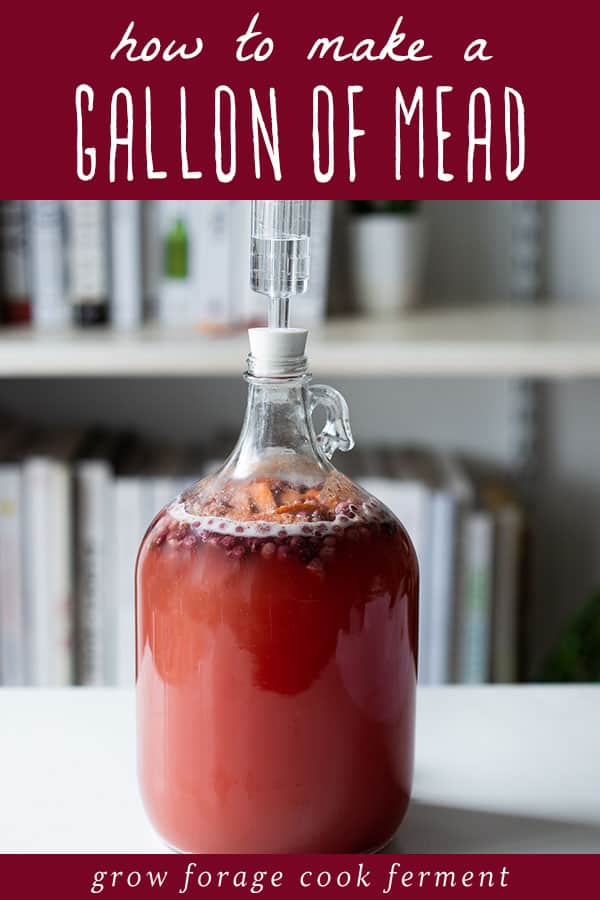
Want to save this post for later?
Simple Mead Making eBook
Want to learn more about making mead? I have a Simple Mead Making for Beginners eBook just for you!
It has ingredient and equipment checklists, detailed instructions for brewing and bottling your mead, and simple mead recipe ideas! Be sure to check it out if you’re new to the mead making process and want a step by step guide.
One Gallon Mead Recipe
Here is my simple method for making one gallon of mead!
What is Mead?
Mead is a fermented alcoholic beverage that is traditionally made with just honey and water, and maybe some yeast (wild yeast is often used).
Whenever you add fruit to mead it’s technically called a melomel rather than mead. I still usually default to calling it mead, though.
You could also use apple cider instead of water and then you’d have what’s called a cyser. If you add herbs and spices or other flavorings it’s called a metheglin.

Mead Equipment and Ingredients
There is some special equipment and ingredients that you will need to make this mead.
Rather than list it all here, I’ve created a page that has links to all of my favorite mead ingredients and equipment: Mead Equipment & Ingredients: Everything You Need to Get Started.
There you will find links to the sanitizer, brewing jugs and buckets, airlocks, yeast, tubing, bottles, and honey and I recommend!

How to Make Mead: One Gallon Mead Recipe
Alright, let’s get started on making this mead!
This is a recipe for one gallon of mead, but I’m always of the mind that if you’re making one you might as well make two.
You can split a package of brewing yeast up between two jugs (one package can make up to 5 gallons of mead).
Sanitize Everything
The first thing to do is sanitize everything that will be used in the brewing process: the jug, airlock, big pot, spoon and funnel.
Simply follow the directions on the sanitizer and don’t throw it out until you’re totally done (just in case your dog licks the funnel or you drop your spoon).
Make the Mead Must
Once everything is sanitized, put about 1/2 gallon of non-chlorinated (filtered) water in a large pot on medium heat. When it’s warm, but not boiling, add the honey and stir until it dissolves.
Using two pounds of honey will make a very “dry” mead (not sweet), while three pounds will create a sweeter mead.
The type of yeast you use will also affect how dry or sweet the mead is.
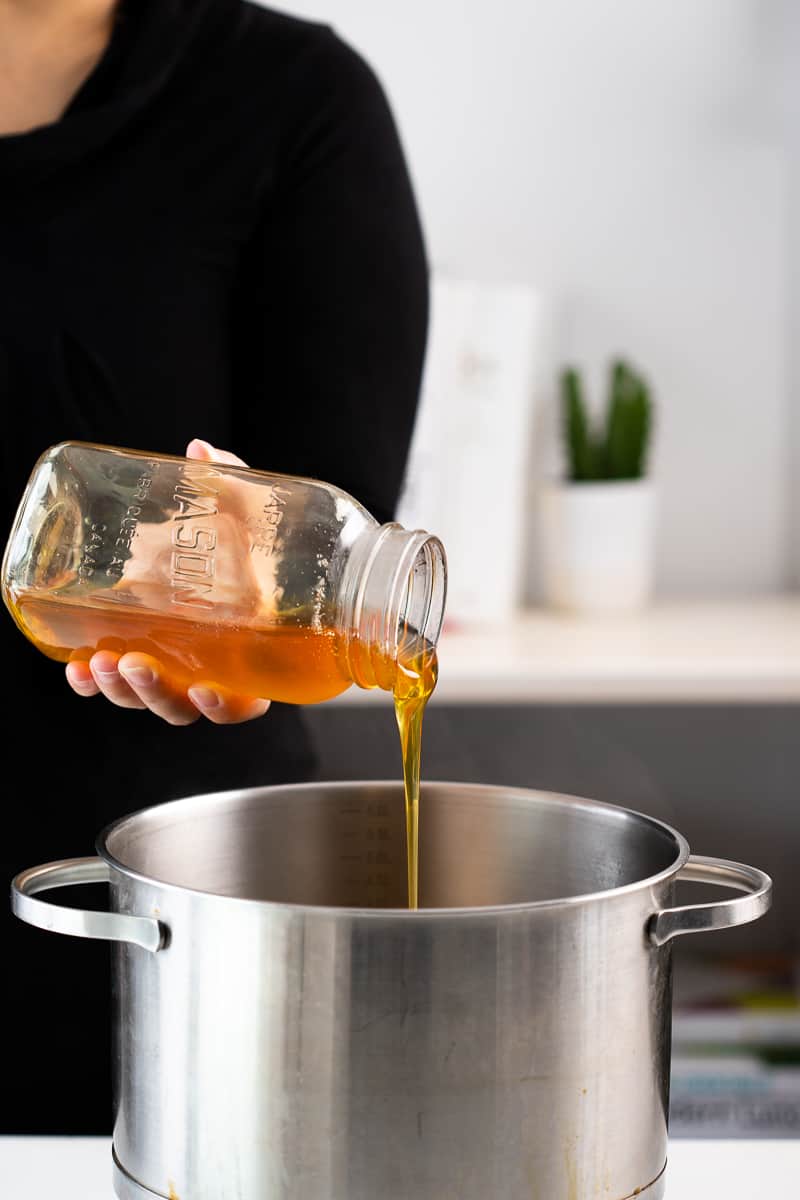
Turn the heat off. It may be a little foamy, but that’s ok.
In the meantime, put the berries (or any fruit of your liking), orange slices (skin and all), and raisins into the one gallon jug.
Raisins are added as a natural nutrient for the yeast. You will not notice any flavor from them in the finished mead.
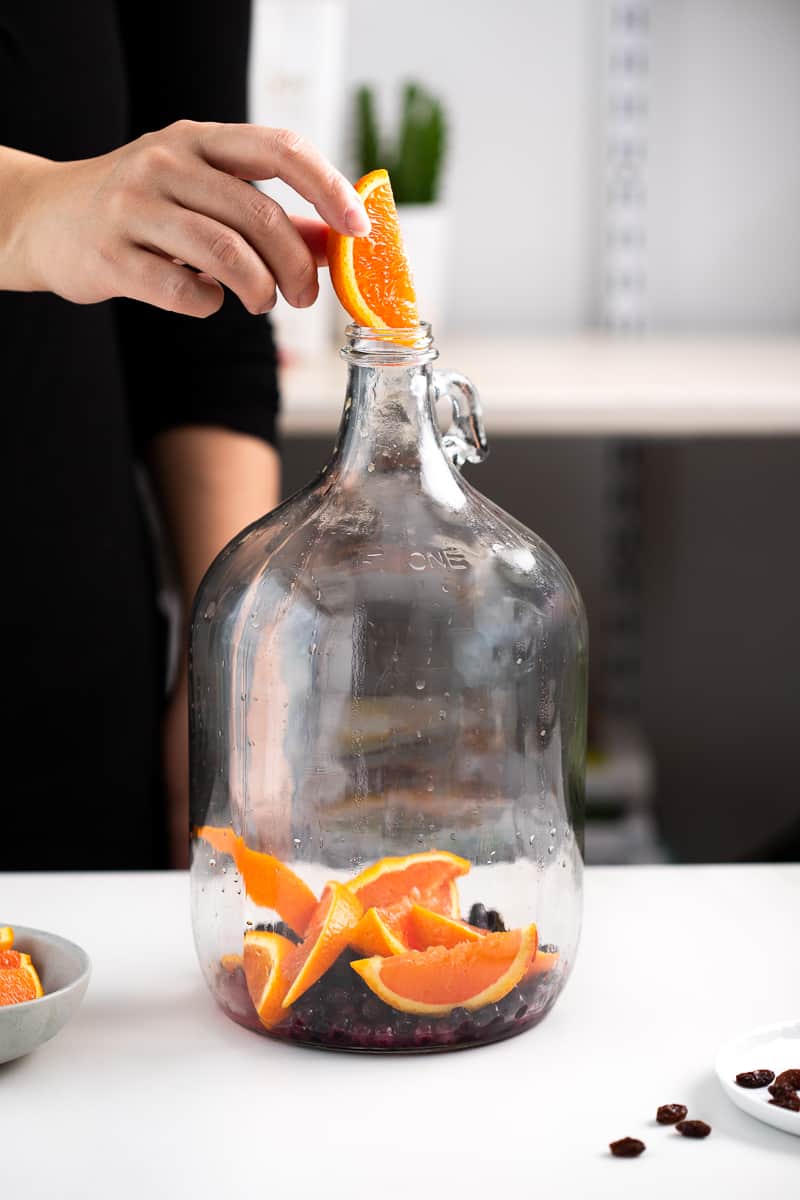
Then, using the funnel, carefully pour the honey water mixture (technically called “must”) into the jug.
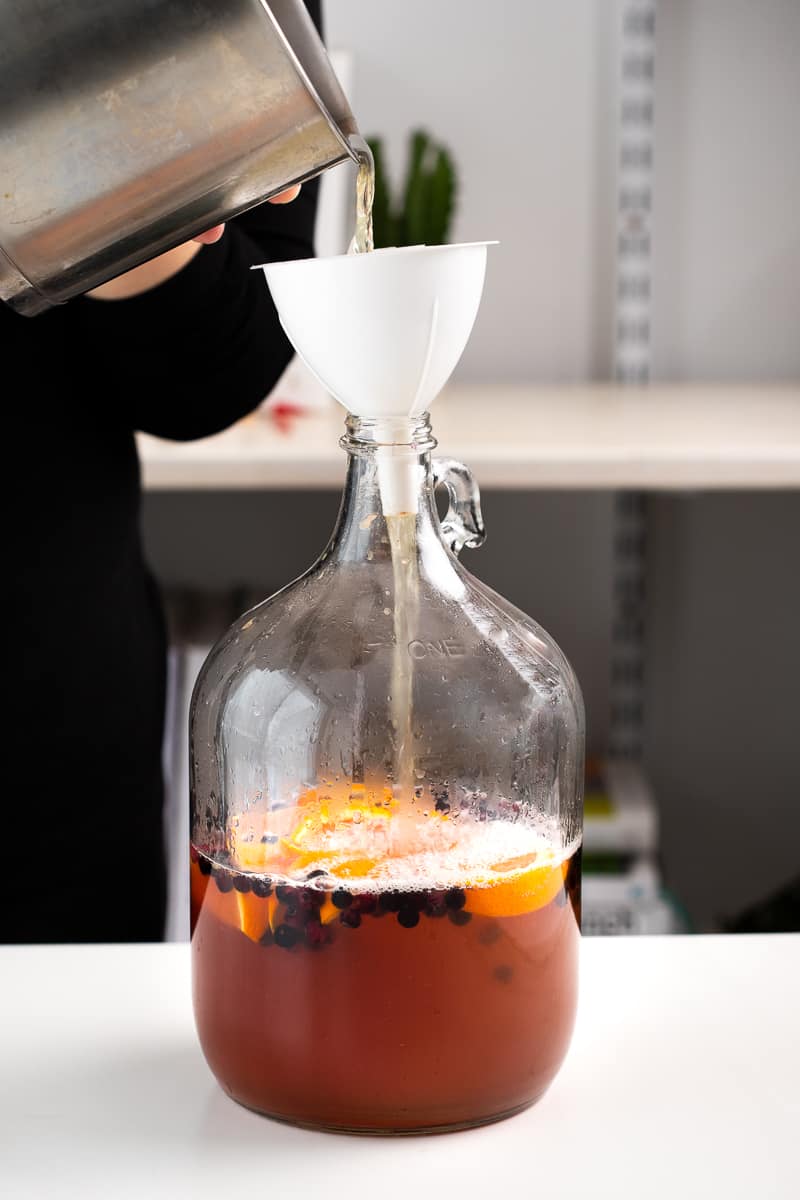
Top off the jug with cool non-chlorinated (filtered) water, leaving at least 2 inches of head space on top.
Then put the lid on the jug and gently mix everything around a bit. If you bought a jug that came with an airlock it may not come with a lid, so you’ll have to find a lid that fits or improvise a bit here. A solid cork (without a hole for the airlock) would work.
Pitch the Yeast
The next step is to add the yeast, but you need to make sure that it isn’t too hot, which will make your yeast inactive. It should feel lukewarm, no more than 90° F (32° C). I recommend using a thermometer before adding the yeast to be sure.
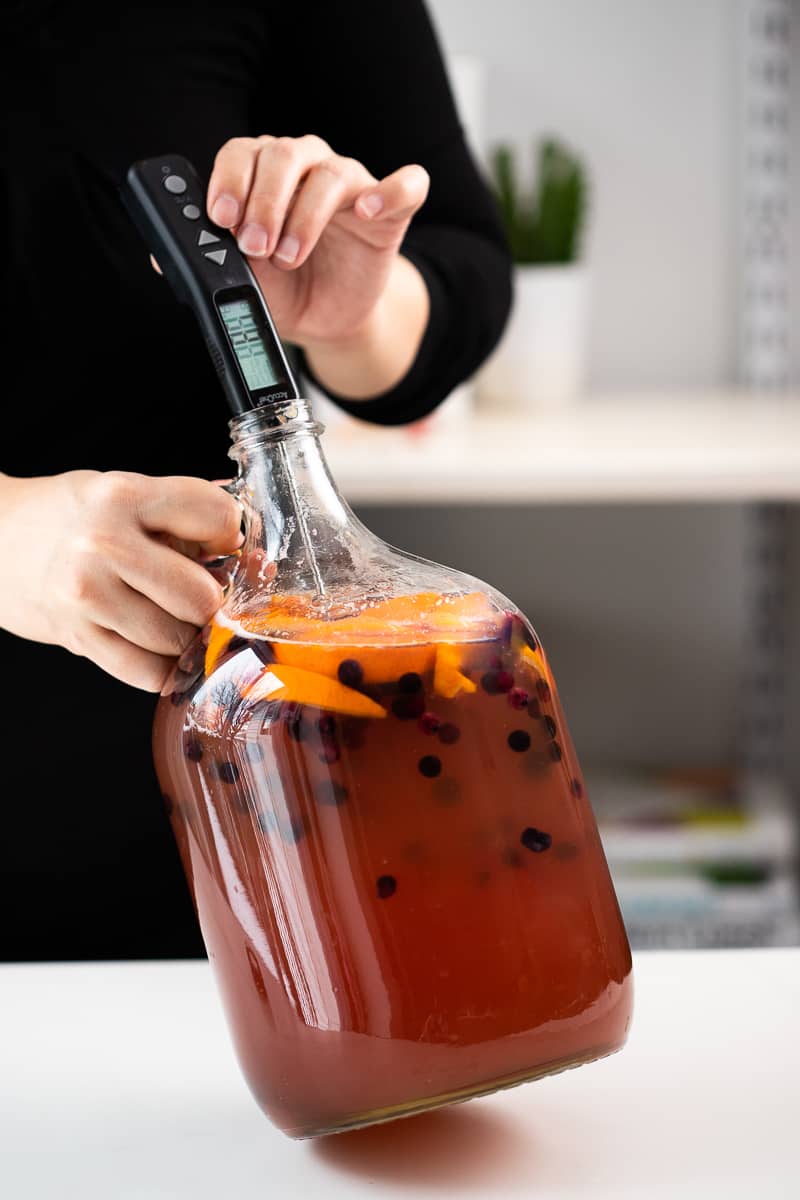
Once it is less then 90° F you can pitch the yeast into the jug.
You don’t need to use the whole package of yeast for one gallon, 1/2 package is enough (it doesn’t have to be an exact measurement). Store the opened yeast package with the remaining yeast in an airtight zip top bag in the refrigerator for later use.
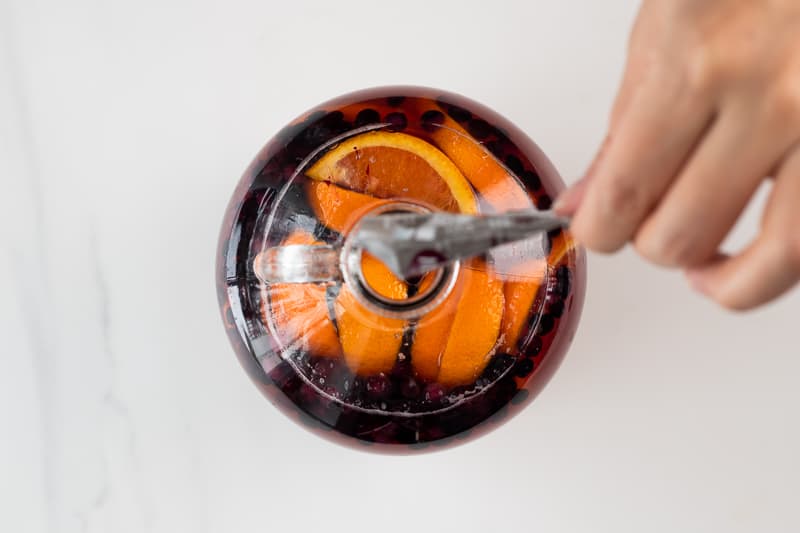
Now the fermentation fun can begin!

Once you’ve pitched the yeast, put the lid back on tightly and this time you’re really going to shake it up for several minutes.
It’s a good workout for your arm muscles, so you can skip the gym on days when you make mead!
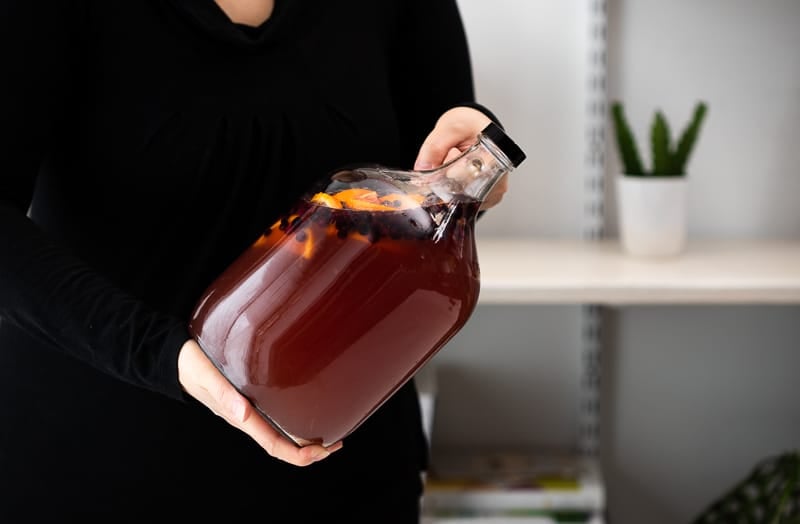
Add the Airlock
Put a little water in the airlock to the line, then put the rubber stopper into the jug.
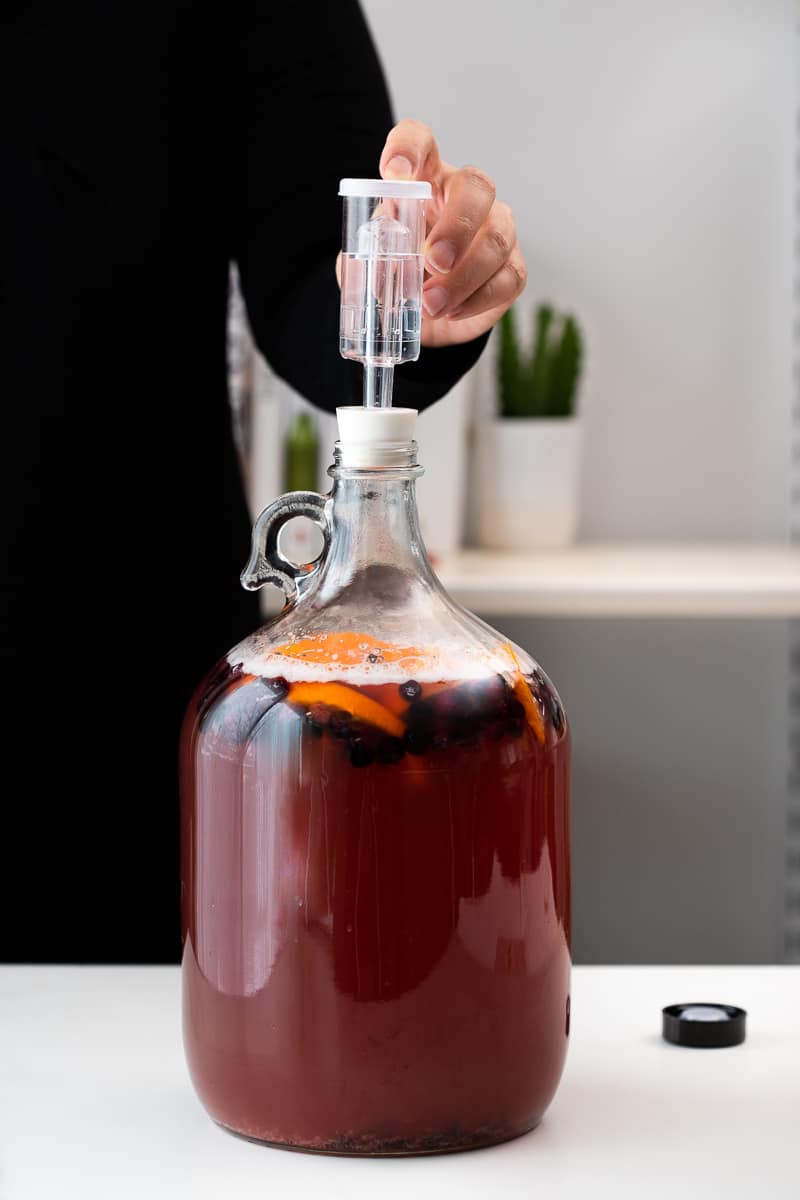
In a few hours you should start to see bubbles forming in the jug and in the airlock.
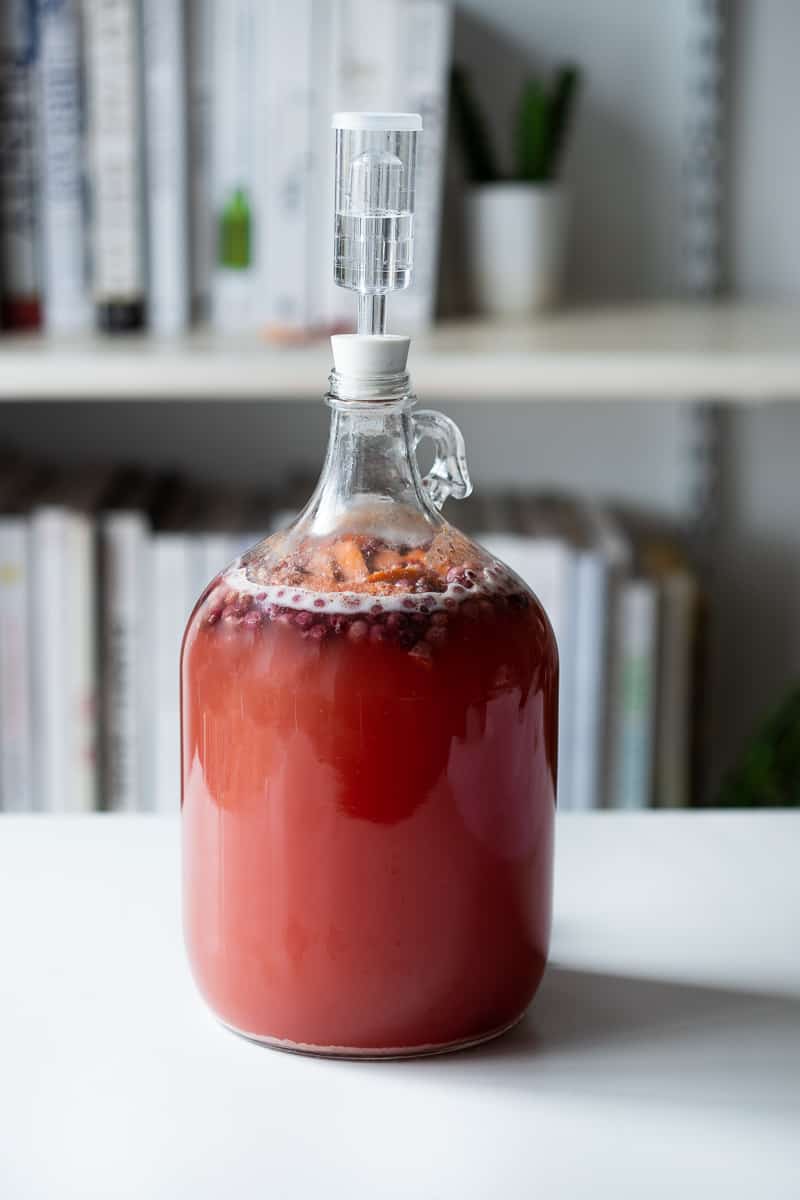
After several hours or overnight, you may see a lot of bubbles rising up the neck of the bottle! The whole top might get a little foamy at first, but things will settle down.
Don’t worry if the bubbles rise up into the airlock for the first couple of days, that just means that you have a very active (and happy) batch of mead! You can periodically remove the airlock to rinse it out, then replace it back into the jug.
I love watching all the little bubbles! Fermentation is so cool.

Set Aside to Ferment
Keep the jug in a cool (not cold) dark place out of direct sunlight to ferment.
Mead can take longer to ferment than hard cider or beer, depending on the ambient temperature it will take anywhere from 3-6 weeks.
I usually give it 5-6 weeks before bottling to be on the safe side, as you don’t want any broken bottle explosions! I’ve definitely had some very champagne like mead before.
You want to wait until you don’t see any bubbles in the jug and your airlock is still before bottling.
Bottle the Mead
Bottling one or two gallons of mead is the same process as bottling hard cider. Follow my tutorial there to get a detailed process.
You may want to wait a while to drink your mead as it definitely gets better with age.
I often drink it “green” (young) as I enjoy it either way. It is fun to save a couple of bottles for several months, or even a year, just to see how the taste changes with age.
More Mead Recipes
Now that I’ve shown you how to make this simple one gallon of mead recipe, chances are you will want to make more soon!
I have written posts on How to Make 5 Gallons of Mead and How to Bottle 5 Gallons of Mead if you want to try making a larger batch.
I have one gallon mead recipes for Wildflower Mead, Dandelion Mead, Blackberry Mead, Elderberry Mead, Elderflower Sparkling Mead, and Maple Orange Mead that are all delicious and follow this same basic mead recipe.
See my post on 15 Easy Mead Recipes for Beginners for even more!
If hard cider is your thing, see my posts on brewing hard cider and making hard cider with wild yeast.
Be sure to check out my Simple Mead Making: A Beginner’s Guide to One Gallon Batches eBook for more detailed information on brewing, bottling, and recipe ideas!
Cheers and happy mead making!
Simple One Gallon Mead Recipe
Equipment
Ingredients
- water non-chlorinated or filtered
- 2-3 pounds honey depending on how sweet you want to end product to be.
- berries or fruit of any kind fresh or frozen, about a cup
- 1 orange
- 10 raisins
- 1/2 package champagne yeast or other wine yeast
Instructions
- Sanitize everything that will be used in the brewing process.
- Heat about 1/2 gallon of non chlorinated water in the pot on medium heat. Once it's warm, but not boiling, add the honey and stir it so it all dissolves. Turn off the heat.
- Put the berries or other fruit, orange slices (skin and all), and raisins into the one gallon jug.
- Use the funnel and carefully pour the honey water mixture into the jug.
- Top off the jug with cold (preferably filtered) water, leaving at least 2 inches of head space on top. Put the lid on the jug and gently mix everything around a bit.
- Make sure that the temperature of the must is below 90°F, then add 1/2 packet of champagne yeast. Put the lid back on tightly and this time shake the jug for a minute or two to distribute the yeast.
- Put a little water in the airlock to the line, then put the rubber stopper end into the jug. Put the jug in a dark place. It should start bubbling within 12-24 hours.
- After about 4-6 weeks of fermenting, once all bubbles have stopped rising in the jug and airlock, the mead can be bottled and aged.
Notes
- Please see my Mead Equipment and Ingredients page for a detailed list of what you need to get started.
- Use my tutorial on Bottling Hard Cider to bottle the mead - the process is the same. The flavor of homemade mead will improve after bottling and aging.
- My Simple Mead Making eBook is a helpful resource if you are just getting started with making your own mead.

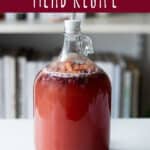


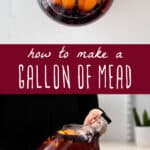
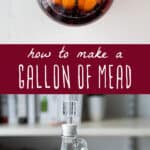
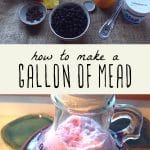
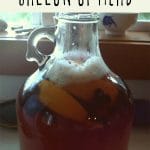
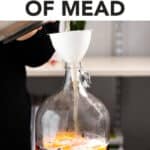
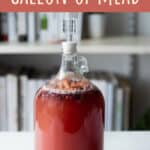
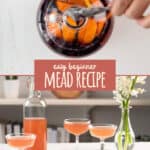




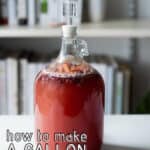
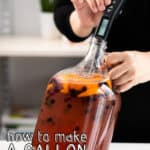
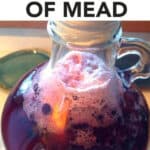
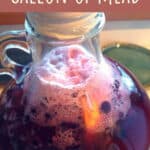
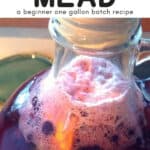
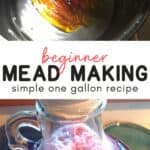
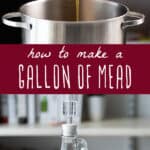
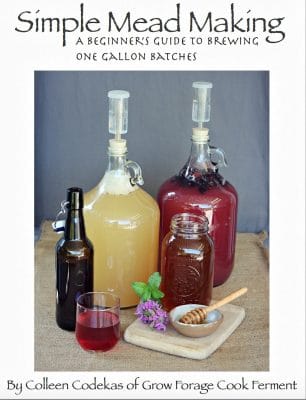


Where do you store the bottled mead ?
Good recipe!
In a cool, dark place.
I made my first batch and it came out pretty well. I am curious though, there isn’t much of a berry flavor to mine (made black berry/peach) could you muddle a few of the berries to help release some of the juices into the mead?
Hi AJ. Yes, you can add additional fruit juice before bottling your mead, if you prefer.
Hi! Is the orange in this recipe necessary or just for flavor? I have a lot of saskatoons on hand which would be a good replacement for the blueberries I’m sure, but really don’t want to have to drive an hour into town for an orange! I have apples if they would work too… Thanks!
You are wonderful, thank you for all this amazing info!
Before bottling, is it possible to add elderberry juice to create another flavor profile and give it a vibrant color? Or does this become tricky/unsafe/ruin the mead? Thank you!
I know this may be a crazy question, but is there a way to make a non or very low alcohol mead? We don’t drink alcohol, but enjoy a mocktail pretty often. We have found an online mead that doesn’t list an alcohol content. So I assume it is possible. Can you please advise? Thanks!
Hi Lola. Yes, you can make a very lower alcohol mead, called a hydromel. You would need to use less honey and more water to reduce the number of sugars that are fermented. Here’s a great blog post on how to make a batch.
How do you get all the rinds out of the jar? I’ve had some stubborn remnants in the past.
I came here hoping this question had already been asked and answered!
Try coarse salt and ice cube. Spin it. That’s how we remove stain in restaurant coffee pot.
My mead stopped bubbling after 1 week. Should I leave it or is there something I should do? I made 2 – 1 gallon batches. 1 is fine the other stopped bubbling.
Wow, what an interesting read, very clear recipe and tips! Thanks everyone for helpful questions and comments above, I am a back yard bee keeper in NZ, this looks like a solid and great use for some of my girls honey, can’t wait to give it a go!
Hi this is my first time making mead, is there any red flags I should look while it’s fermenting?
IVE MADE WINE OUT OF GRAPES FOR YEARS IM GOING TO TRY THIS STARTING TOMORROW. WHAT IS A GOOD GRADE OF YEAST TO USE?
Hi Richard. I use this Champagne yeast.
Just started my second batch off this recipe (it’s my 1st go) I’m very impressed. My 1st brew I left in for 4 weeks then racked it for 3 weeks iv had a cup and I can tell iv had it lol iv added a lil more honey for my second attempt just to trial and error. Very happy up to now
Hi Sean. So glad to hear you enjoyed this recipe!
Very nice page. Enjoyed the read and the comments. Question: Do you have to bottle the Meade or can you rack it into another carboy and store in cool area?
Hi Scott. Yes, you could rack it into another carboy if you prefer.
Believe it. 35 years old and I just heard about mead a day ago. I googled how to make mead and I cam across your blog. Simple easy to understand instructions and nice photography. I have not tried it but I intend to and im considering purchasing your book. question; what typeof honey? does Honey type makes a difference?
Hi Vince. I try to use good quality honey (natural, without any additives) that is local to where I live. It can be raw or pasteurized.
Is it a used procedure to process the mead through a filter, like a coffee filter to remove heavy sediment prior to the jarring and aging process?
Hi I am at day 16 and the air lock is not doing much, I have done a swirl on day 15. Is this normal?
Followed your recipe and just about to bottle up. Do you add anything to clear the mead?
It’s a nice red cloudy liquid right now. I’ll probably keep this batch simple, as intended and bottle as it is. But wondered if it will clear with time or wherever there are any non chemical methods.
Yes, racking and aging the mead, will help clear it.
I just found your recipe and am excited to try it. I always wanted to try making mead and now I have the means to do it. I will do this with my brother in law who made wine and got brandy. Wish me luck!
Good luck!!
Can this be bulk aged if I rack it to a different carboy? Or just age in bottles?
Yes, you can do that.
Could I use just a regular bread yeast in a pinch?
In a pinch, yes, you can use bread yeast, but keep in mind that brewer’s yeast has been selected for it’s characteristics that enhance flavor and consistency.
Ive successfully made this mead! However it does taste a bit medicinal and isn’t very sweet. I actually like it but is there a way to increase the sweetness?
There are several ways to back sweeten mead before bottling. You can learn more here: Back Sweetening Mead
I do have a question for you. I just got done reading the how to make a gallon mead. I was wondering if you have ever heard of anyone making Huckleberry mead? Here in Idaho there is a lot of wine made with it but could it be used in this process?
Hi Kevin. Yes, you can definitely make huckleberry mead! I would follow my instructions for blackberry mead, subbing the blackberries with huckleberries.
I have a question Colleen. You’ve recommended 3-6 weeks, but have you ever gone longer than that? what’re the consequences of going upwards of 3-6 months fermentation? Just a very dry mead?
Thanks for indulging me! Well written instructions and great photography!
Hi Emmett. I recommend 3-6 weeks for fermentation because that’s typically the extent of fermentation. Meaning, there won’t be enough sugar left in the mead to support fermenting it for 3-6 months. Also by doing so, you may increase your chance of causing an off-flavor since your mead would be sitting on settled yeast for far too long.
Once it’s done bubbling do I need to filter it? And the recipe calls for half a packet of the yeast but I used a whole packet. Is that ok?
What is the alcohol content of the mead for recipe above?
Hi Brook. I didn’t measure the ABV when I made this recipe, sorry!
hello brook. the recipe has around 750 grams of sugar per litre (going by a gallon of mead made by two pounds of honey). which would give us a OG of 1.076. if FG would be 1.010, you’d get around 8.8%. I would aim for 250 or 300 grams of sugar per liter (honey is 82% sugar by weight) to get a stronger brew but it’s up to your choice. meads with lower alcohol content is more drinkable when young. stronger the brew, longer it takes for it to mature.
Looking forward to making this. Have you ever used it for a tincture? I watch rain country on youtube and she makes her own wines for her tinctures. So glad I found your blog. Searching through everything.
Hi Leslie. No, I have never tried that. Thanks for sharing!
I was wondering, the glass jar link is currently unavailable can I use a different fermenting glass top with the stopper or maybe a one gallon wide mouth with the same glass on top? Make sense?
Sure!
:) Yes. Its me again. I started my mead per your recipe on Sept 14, and as of today, there are no more bubbles in sight. I was greatly saddened by this. I asked questions in a mead forum that I found and it was suggested that I check my brew with a hydrometer. The problem is I didn’t test it at the start of the process. Is there any chance that you know the specific gravity of the mead at the start? I also took the vent lock off and sniffed, I can definitely smell alcohol no mistaking that. Could the brew have just finished early? Thanks in adavnce :)
OK, i am finally going to try this! But: i have black currants saved from this summer. What quantity of those should i use? (instead of the blueberries and orange here) and can i ommit raisins? i hate raisins and don’t want to buy just a few for this one task ;) Also, we have well water that has iron/sulphur…. i use it for all my ferments but should i consider buying filtered water instead? There is also a local spring with delicious water that i could use…. Not sure if i should be boiling any of the water i might use first to be sure it’s ‘clean’ or something…
tia!
Hi there. I’m not exactly sure how many black currants you should use, but I used 10 cups of elderberries in my elderberry mead recipe and that was plenty. You may need to adjust based on the sweetness of your berries. As for the raisins, they are added as a natural nutrient for the yeast and are needed. You will not notice any flavor from them in the finished mead. I would also consider using the local spring or filtered water as opposed to the well.
Hi Colleen.
As promised I’m just letting you know how my brew turned out. It has a kick, seems to be quite alcoholic and is unique in flavour!
I only have 1 problem it’s acidity, it has a strong pithy, orange peel after taste. I’m not sure if I’ve put too big an orange in it or if my mix was off in some way!? Any suggestions?
Great fully yours Tony from England
Here goes ! I have cultivated blackberry bushes – large berries with with very large hard seeds. I am worried about my teeth- hence I thought I make mead. So I could sieve this before bottling up please ? Thank you for sharing. Louise
For sure!
Thanks for the recipe and helpful hints. I started off using a glass one gallon jug from a wine making kit, but now I want to increase production. I have a plastic 5 gallon water fountain cooler carboy from when we lived in an area with high sulphur water. Can I use this safely or am I better off going with glass? By “safely” I mean would the plastic be able to get thoroughly sanitized, handle the slight pressure buildup, and not impart any chemical tastes to the final product? Thank you!
Hi Craig. It’s really hard for me to say since I’ve never used the vessel you’re referring to. If the plastic is BPA-free, free from cuts of dents in the plastic, and able to release built-up gases, I would think it’s totally fine to use.
Hello! I am new to homebrewing and have very much enjoyed following this recipe! However when I bottled it recently, I took a taste and my mead was very sour- like the oranges I used turned it sour in the process. Is this the “green” taste? Will it improve with time? Or have I made a mistake? Either way, five stars for you and your recipe! Thank you for sharing!!
Hi! I am about to try out making mead for the first time and I purchased your e-book to help me out. I really appreciate how simple your process is! I have a couple of questions: I have a couple of enamel pots I use for canning – can I use those instead of a stainless steel pot? Next, I am a beekeeper and I want to use honey that has crystalized and started to ferment slightly – is this okay to use? I’ve seen varying opinions on this. I am currently storing this honey in my fridge to slow the fermentation process down. Thank you in advance for any help you can provide!